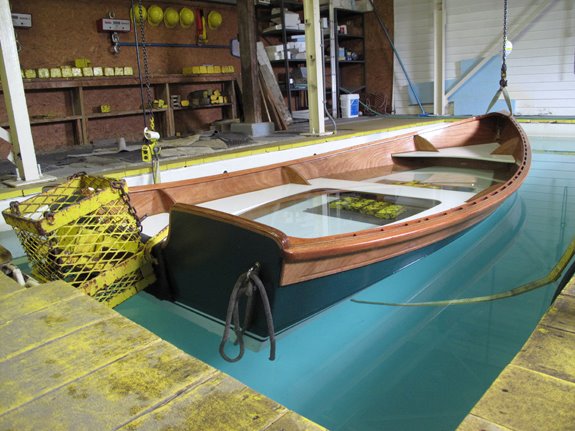
Sinking the Peeler Skiff...for a Good Cause
Powerboat designs, even those sold as kits like our new Peeler Skiff, must comply with stringent Coast Guard regulations. The Coast Guard checks the designs in a special tank manned by marine engineers. These tests are voluntary, but a great way to be absolutely sure about the safety of a design before it goes on sale. We passed with flying colors. I accompanied the boat for much of the two-day test and had permission to snap photos.

The Peeler Skiff dangling over the test tank.

The first test, and one of the most interesting, was simply to see how much weight could be added before the water came over the sides. The weights were pig iron. Each of those yellow-framed units is around 800lbs. The Peeler Skiff's bottom certainly wasn't designed to handle that kind of extreme point-loading. I really was wondering if all the weights would fall through the bottom of the boat! But not a creak or a crack.

At 5000 pounds (!) exactly, there was a quarter-inch of freeboard left. Back at CLC, I had calculated that we'd reach that point at 5009 pounds. A head-swelling moment for this designer: off by only eighteen-hundredths of one percent! What is the point of this test? The boat has to be able to carry five times your rated safe capacity. Thus, 1300 pounds for the boat's displacement, minus the 300 pounds of neutrally-buoyant hull material (okoume plywood and epoxy), leaves us with 1000 pounds for passengers, motor, battery, fuel tank, and gear.*
Just so I don't get emails, the point here is not to suggest that a Peeler Skiff can drive around with 5000 pounds aboard. (A Ford Explorer weighs 4455 pounds.) Rather, properly loaded, it has a big margin to survive misadventure.
**Note: In recent years, the US Coast Guard revised the calculation for allowable passenger weight. In the decades since the relevant laws were written, the average Americans boater has...gotten heavier. Our capacity calculations for the Peeler Skiff were sufficiently conservative that we didn't have to revise the advertised payload.

For flooding tests, they simulated the weight of a 15hp 4-stroke outboard by clamping this metal basket to the stern and filling it with weights. 15hp is the maximum allowed on the boat, and quite a lot more than it needs!

The weight of the battery, which lives under the center seat, was simulated with iron bars. I was relieved that they didn't make us ruin a nice Mercury engine and battery for the tests!

Here, one of the engineers finds the center of buoyancy by experimenting with various weights (and people) representing a typical load of crew and gear.

The boat was flooded to the rails to see how it behaves when swamped. 16 holes were drilled in the three flotation compartments to simulate a catastrophic scenario in which the compartments were breached. (The compartments are filled with foam, per CG requirements.) Too bad about the holes in the nice finish, but it's all for a good cause. We were able to repair them easily.

Flooded, and with the drain plug in the transom open, the boat was left in the tank for 18 hours, to soak up as much water as possible. THEN stability was tested.

After 18 hours, the Peeler Skiff had "self-bailed" to this level, with the water well below the seats. I actually watched water flowing OUT of the transom drain plug---they held a little indicator next to the plug to test the direction of water flow. These guys test thousands of small powerboats, and don't seem capable of being impressed by much, but they liked the Peeler Skiff very much. It passed all tests and is about as safe as a 15-footer can possibly be.